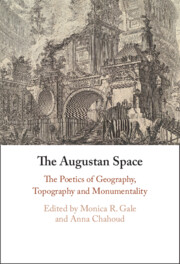Book contents
- The Augustan Space
- The Augustan Space
- Copyright page
- Contents
- Notes on Contributors
- Preface
- Abbreviations
- Introduction
- Chapter 1 The City in Horace’s sermo
- Chapter 2 excucurristi a Neapoli
- Chapter 3 Poetic and Imperial Spaces in Propertius, Books 1–3
- Chapter 4 Horace on Sacred Space
- Chapter 5 Roman Topography, Politics and Gender
- Chapter 6 aurea nunc, olim siluestribus horrida dumis
- Chapter 7 Hippolytus and Egeria in the Woods of Aricia (Virgil, Aen. 7.761–82 and Ovid, Met. 15.479–551)
- Chapter 8 locum tua tempora poscunt
- Chapter 9 imperii Roma deumque locus
- Chapter 10 The Rise and Fall of Virgil’s Sublime Carthage
- Chapter 11 Eccentric Poetry
- Chapter 12 Virgilian Heterotopias
- Chapter 13 loci desperati
- Works Cited
- Index Locorum
- General Index
Chapter 6 - aurea nunc, olim siluestribus horrida dumis
The luci Molorci and the Augustan Space in Virgil’s Georgics and Aeneid 8
Published online by Cambridge University Press: aN Invalid Date NaN
- The Augustan Space
- The Augustan Space
- Copyright page
- Contents
- Notes on Contributors
- Preface
- Abbreviations
- Introduction
- Chapter 1 The City in Horace’s sermo
- Chapter 2 excucurristi a Neapoli
- Chapter 3 Poetic and Imperial Spaces in Propertius, Books 1–3
- Chapter 4 Horace on Sacred Space
- Chapter 5 Roman Topography, Politics and Gender
- Chapter 6 aurea nunc, olim siluestribus horrida dumis
- Chapter 7 Hippolytus and Egeria in the Woods of Aricia (Virgil, Aen. 7.761–82 and Ovid, Met. 15.479–551)
- Chapter 8 locum tua tempora poscunt
- Chapter 9 imperii Roma deumque locus
- Chapter 10 The Rise and Fall of Virgil’s Sublime Carthage
- Chapter 11 Eccentric Poetry
- Chapter 12 Virgilian Heterotopias
- Chapter 13 loci desperati
- Works Cited
- Index Locorum
- General Index
Summary
It is well known that Virgil’s reference to the ‘woods of Molorcus’ in the prooemium of Georgics 3, echoing Callimachus’ poem staging this otherwise unknown figure in his Victoria Berenices, enables the Roman poet to signpost his reappropriation of the Alexandrian epinicion within the loaded context of the celebration of Octavian’s victory over Egypt. In line with this interpretation, this chapter focuses more closely on Molorcus himself and his (devastated) land as a significant theme in its own right. By alluding to the story of this impoverished farmer unable to perform his ‘georgic’ tasks in a poem centred on the countryman’s labour, Virgil retroactively constructs his Callimachean model as a failure to live according to the main precepts of his didactic poem, thus making the land of Molorcus appear as an anti-type of Octavian’s idealised rural Italy. Moreover, this failure is connected to the havoc created by a ‘terrible lion’ whose slaying by Heracles readily offers an image of the princeps’ victory over his foes, thus making the poor farmer’s land a contrasting prefiguration of the hoped-for Augustan space.
- Type
- Chapter
- Information
- The Augustan SpaceThe Poetics of Geography, Topography and Monumentality, pp. 98 - 113Publisher: Cambridge University PressPrint publication year: 2024



